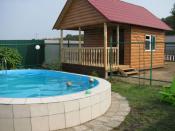Search
Login
Recommended
Vertical gardens in the interior of a modern house
The technological process for the design of vertical gardens was offered to everyone by the French naturalist designer Patrick Blank. The first vertical garden of Blanca was made of a metal frame with plastic fiber decking, its design allowed the plants to receive useful trace elements and moisture. It was in this design that he planted seedlings of plants. Patrick Blank brought to life the scheme according to which plants are fed through a super-high irrigation system, and not through the soil in pots for planting. The weight of the structure is relatively small - 1 square. m. weighs only 30 kilograms.
Content:
- Vertical gardens - creation technology video
- Vertical gardening today is experiencing a peak in popularity video
- Plants for vertical gardening
- We create a vertical garden in the apartment with our own hands video video
Vertical gardens - creation technology

The idea of \u200b\u200bthis design of the garden came to Blanca after careful research on Asia Minor forests. In Malaysia, mainly plants grow in rocky terrain, therefore they can get light, nutrients and moisture while standing upright. Having made certain conclusions, he developed a system of vertical planting of plants.
Vertical gardening has several technological design methods that differ only in the manner of fastening and the placement of seedlings:
- Modular gardens - assembled from boxes made of plastic, metal or textile. Plants are planted in each individual box, and then all the fragments are brought together. This design method resembles a game with a children's designer.
- Carpet gardens - are created from a single textile polymer fabric. On this plane, many pockets are equipped.
- Pallets - a wooden floor with plants planted in it, which are visible between the slats.
- Vertical picture gardens - are mounted using a mesh of metal. At the end of planting, the resulting phyto-composition resembles a picture.
Vertical gardening today is experiencing a peak in popularity

Vertical gardening today is a fairly fashionable trend in the design of premises. Modern decorators make such landscaping exclusively from living plants. Such a fashionable direction of design is often discussed in television programs devoted to the repair of apartments or private houses. In addition, vertical gardens are used as decor in almost all large offices and expensive gourmet restaurants.

In addition to an interesting and unusual idea, vertically planted plants:
- will make it possible to preserve the useful area of \u200b\u200bthe floor or window sill,
- fill the room with oxygen
- significantly improve the state of the microclimate (improvement occurs because with this method of landscaping the process of continuous evaporation of moisture proceeds),
- if desired and necessary, they can provide maximum penetration of sunlight into the room (a structure with landscaping can be placed at a decent distance from the window opening).
Plants for vertical gardening

When choosing seedlings of various flowers and plants for landscaping, it is necessary to remember that in addition to a well-coordinated composition, a peculiar ecosystem must also be created, which will enable comfortable growth and development. Selected varieties must necessarily require similar care and the same climatic conditions. In the process of thinking about creating a garden, it is important to remember that after a certain time, the plants will grow, and the appearance of the composition will change accordingly.

Creating a vertical garden with your own hands, special attention should be paid to the proper selection of plants. They must have a developed strong root in order to reliably hold on a vertical plane. As for the stem, it should not be long, or like a vine. Leaves of medium or small size, growing in a bushy manner, will look more spectacular. Creating the first living composition, it is better to plant plants requiring minimal care. For this option, florists are advised to pay attention to ampelous plants, ivies, grapes. They quickly develop and curl, while densely filling with themselves the entire area of \u200b\u200bthe structure.

For the design of a living wall in a house (office, restaurant, and so on), succulents and similar plants are perfect.

Logically and peculiarly on the living kitchen wall will be greens and herbs (small salad, basil, mint, dill).
We create a vertical garden in the apartment with our own hands

Depending on the desire, a vertical garden can be designed as one type of plant or several, creating a kind of picture. Before obtaining certain skills and experience in this area, it is better to buy plants not expensive seedlings. In the case when any single instance fades, it can always be replaced with a similar one or purchased the same.
The location of the living wall often falls on the wall located opposite the window opening, so you should consider in advance how and what it will be better to design the backlight for. Experts advise using fluorescent lamps, preferably energy-saving.

They cost an order of magnitude more expensive than ordinary ones, but consume less electricity. This fact will be especially acute in the winter, when you will have to use the daylight for about 12 hours a day.

The vertical garden must be equipped with automatic irrigation. Such a system can either be purchased at a specialized flower shop, or made with your own hands from polypropylene material. In cases where the composition of plants is made independently and has not very large dimensions, the irrigation system can not be equipped, but then it will have to be placed so that it has free access, which will provide constant unhindered watering.
There are many ways that will help to arrange vertical gardening in the apartment.

Special equipment for installation can be bought, or you can do it yourself. In principle, the main difference between the arrangement of green structures is that some of them involve planting seedlings in the ground, and others involve growing seedlings in hydroponics. The first option and the second have pluses. Everyone who decides to green their homes with a vertical garden should consider what care and installation would be easier and more acceptable for him.

The designs in which hydroponics is involved are based on the use of polymer fiber, on which many pockets of the same fiber are made. The entire fiber web is firmly fixed to the frame. Saplings, in the process of growth, are reliably strengthened by the root system in the felt, on which they are kept and from which they feed. If necessary, as well as in cases with ordinary flower pots, they can be replaced or transplanted. Felt can be purchased at a specialized store at a relatively low price. It is also necessary to take into account the fact that plants growing on hydroponics should be fed at least once a month. Many people believe that such a vertical design, even taking into account all the costs, is slightly better than others, because its design is mounted quickly and easily, it does not weigh much, and therefore does not need additional strengthening.
A living wall based on boxes filled with earth is much more heavy. But thanks to this division of seats, you can plant much more varieties and species of plants. Caring for such a garden is usual and does not require additional actions and time. But to mount such a design will need much more space than for felt.
You can make a vertical garden with your own hands as follows. The basis of the design can be built from fragments of the drainpipe polypropylene system, you only need to give them the right size and install the caps at the edges. You should also take care of reliable fastenings that will allow you to securely fasten the structure to the wall. This design option for a vertical garden does not take much time and does not require large financial investments.

The main positive point when using fragments of the drainage system is that this material is completely tight and will not allow water used for irrigation to flow down the wall.

After completion of installation work, gutters fixed at a certain level and distance are filled with expanded clay, then with earth, after which plant seedlings are planted. When watering such a vertical garden, you need to remember that you need to do this slowly, in order to prevent overflow of water.





